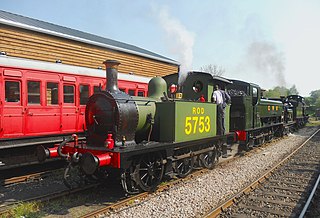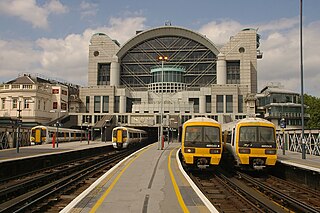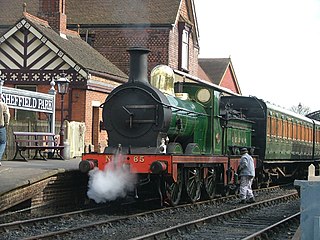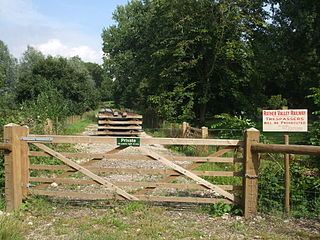
The Kent and East Sussex Railway (K&ESR) refers to both a historical private railway company in Kent and East Sussex in England, as well as a heritage railway currently running on part of the route of the historical company. The railway runs between Tenterden Town and Bodiam.

The A28 is a trunk road in the counties of Kent and East Sussex in south east England, connecting Margate, Canterbury, Ashford and Hastings.

Tenterden is a town and civil parish in the Borough of Ashford in Kent, England. In 2021 the parish had a population of 8,186.

The Hastings line is a secondary railway line in Kent and East Sussex, England, linking Hastings with the main town of Tunbridge Wells, and London via Tonbridge and Sevenoaks. Although primarily carrying passengers, the railway also serves a gypsum mine which is a source of freight traffic. Southeastern Trains operates passenger trains on the line, and it is one of their busiest lines.

Headcorn railway station is on the South Eastern Main Line in England, serving the village of Headcorn, Kent. It is 45 miles 20 chains (72.8 km) down the line from London Charing Cross. The station and all trains that serve the station are operated by Southeastern.

Robertsbridge railway station is on the Hastings line in the south of England and serves the village of Robertsbridge, East Sussex. It is 49 miles 47 chains (79.8 km) down the line from London Charing Cross. The station and all trains serving it are operated by Southeastern.

Rye railway station is a Grade II listed station, serving Rye, East Sussex, England. It is on the Marshlink line between Hastings and Ashford International and is the principal station between those two terminals. The station is a passing place between two single-track sections. Services are provided by Southern, usually between Eastbourne and Ashford.

Ashford is a constituency in Kent created in 1885 and represented in the House of Commons of the UK Parliament since 1997 by Damian Green, a Conservative who served as First Secretary of State between 11 June and 20 December 2017.

The South Eastern Main Line is a major long-distance railway route in South East England, UK, one of the three main routes crossing the county of Kent, going via Sevenoaks, Tonbridge, Ashford and Folkestone to Dover. The other routes are the Chatham Main Line which runs along the north Kent coast to Ramsgate or Dover via Chatham and High Speed 1 which runs through the centre of Kent to the coast at Folkestone where it joins the Channel Tunnel.

The South Eastern Railway (SER) O Class was a class of 0-6-0 steam locomotive designed for freight work, and were the main freight engines of the SER, and later the South Eastern and Chatham Railway (SECR) for a number of years. However, they were displaced by the more powerful C class locomotives following the amalgamation of the South Eastern Railway and London, Chatham and Dover Railway (LCDR) in 1899. This relegated the class to working on the numerous branch lines in Kent, on both passenger and freight work. They worked most notably on the Kent & East Sussex Railway and East Kent Railway, operating coal trains from the Kent coal fields to London, as well as shunting work at such locations as Shepherds Well, Hoo Junction and Ashford. The majority were withdrawn before the outbreak of the Second World War in 1939, and those that remained were slowly withdrawn from nationalisation onwards.

The Rother Valley Railway (RVR) is a heritage railway project based at Robertsbridge in East Sussex, England. It takes its name from the original name for what later became the Kent and East Sussex Railway, running from Robertsbridge through to Headcorn in Kent, via Tenterden. The project is to replace the "missing link" between Robertsbridge, a station on the Tonbridge to Hastings mainline, and Bodiam on the Kent and East Sussex Railway, a heritage railway which operates from Bodiam to Tenterden.
Transportation needs within the county of Kent in South East England has been served by both historical and current transport systems.

Rolvenden railway station is a heritage railway station on the Kent and East Sussex Railway in Tenterden, Kent, in the United Kingdom.

The Hawkhurst branch line was a short railway line in Kent that connected Hawkhurst, Cranbrook, Goudhurst and Horsmonden with the town of Paddock Wood and the South Eastern and Medway Valley lines, a distance of 11 miles 24 chains.
The Headcorn and Maidstone Junction Light Railway was a proposed railway in Kent. An Act of Parliament authorised its construction, but only a short branch at Tovil, opened to goods only, was built.

The High Weald Landscape Trail (HWLT) is a 145-kilometre (90 mi) route in England between Horsham, West Sussex and Rye, East Sussex, designed to pass through the main landscape types of the High Weald Area of Outstanding Natural Beauty (AONB). It does not follow the highest ground, and the eastern section is only a few feet above sea level. It keeps to the northern edge of the High Weald except in the west where it runs close to the southern edge for a short distance.

Junction Road Halt, also known as Junction Road (for Hawkhurst), was a halt station on the Kent and East Sussex Railway. It was located on the eastern side of the level crossing across the B2244 Junction Road near the hamlet of Udiam in East Sussex, England. Closed for passengers in 1954 and freight in 1961 with the line, The line through Junction Road Halt may yet be revived as the Rother Valley Railway, a preservation society, is proposing to reopen the line from Robertsbridge to Bodiam.

Wittersham Road is a railway station on the Kent and East Sussex Railway. It is located to the north-east of the level crossing on Maytham Road which links the Kentish villages of Rolvenden and Wittersham. Having served the area for over sixty years, the station closed for regular passengers in 1954 and completely in 1961. It was later rebuilt and reopened in 1977 by the Kent and East Sussex Railway heritage organisation.

Northiam railway station is on the Kent and East Sussex Railway. It is located to the west of the level crossing on the A28 road linking the Kentish village of Newenden and the East Sussex village of Northiam. Having served the area for over sixty years, the station closed with the line in 1961, but was later reopened in 1990 by the Kent and East Sussex Railway heritage organisation.
Headcorn Junction railway station was the Kent and East Sussex Railway's northern terminus. It was adjacent to the South Eastern and Chatham Railway's Headcorn station. It opened in 1905 and closed in January 1954.

















